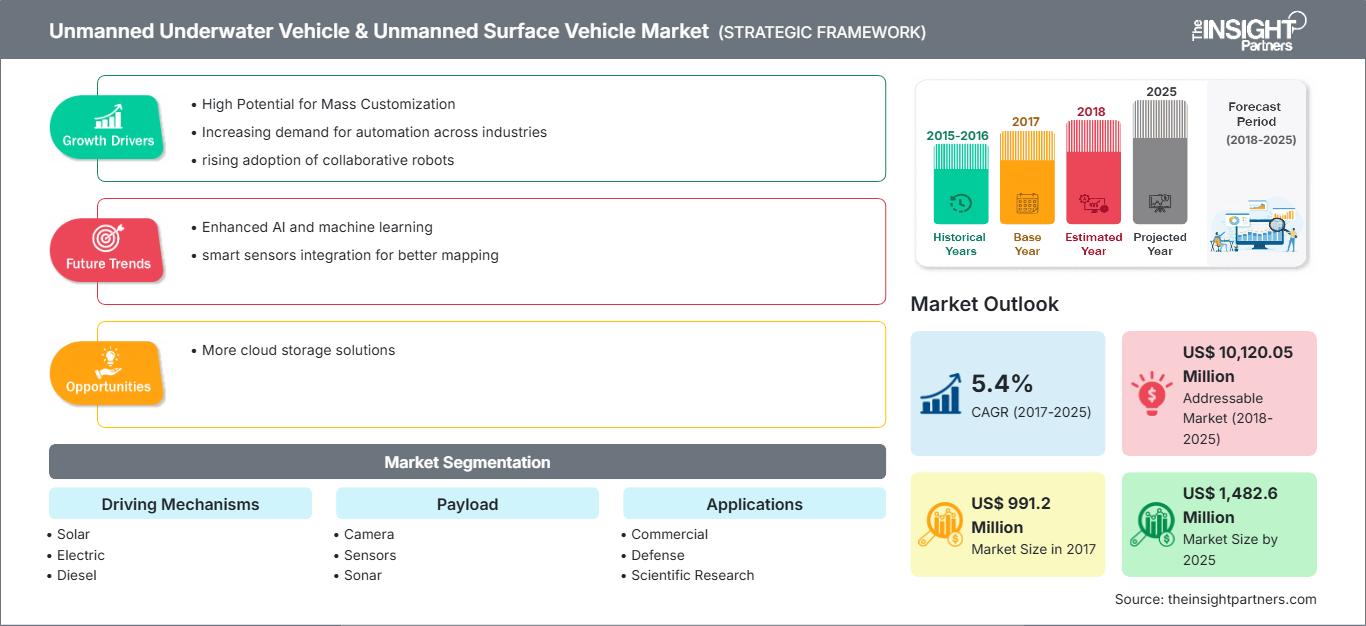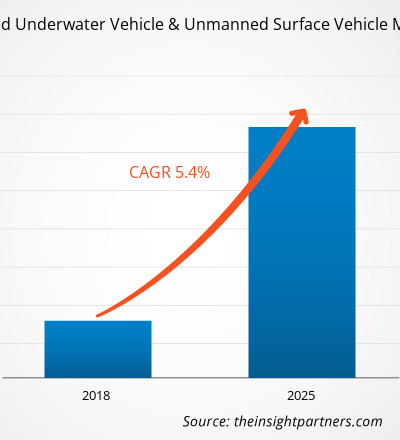세계 무인 수중 차량 및 무인 수상 차량 시장은 2017년 9억 9,120만 달러에서 성장할 것으로 예상되며, 2018년부터 2025년까지 연평균 성장률 5.4%로 성장하여 2025년에는 14억 8,260만 달러에 이를 것으로 예상됩니다.
무인 수중 차량 및 무인 수상 차량은 인간의 개입 여부와 관계없이 수중 및 수면에서 작동하는 드론입니다. 해저 모니터링에 대한 수요가 계속 증가함에 따라 전 세계 UUV 및 USV 시장의 대부분은 국방군이 점유하고 있습니다. 현재 석유 및 가스 탐사 기관, 수로 및 해양 조사 기관, 환경 모니터링 기관, 수색 및 복구 팀 등 다양한 상업 분야에서 UUV 및 USV 도입 추세가 증가하고 있습니다. 무인 수중 차량 및 무인 수상 차량은 또한 해양 연구 및 해양 조사를 위해 다양한 과학 연구 기관에서 채택되고 있습니다. 남미 무인 수중 차량 및 무인 수상 차량 시장은 향후 몇 년 동안 연평균 4.6%의 성장률을 기록할 것으로 예상됩니다.무인 수중 차량 및 무인 수상 차량 시장 분석
해양 산업 수요 급증
여러 국가가 해상 무역로와 수중 석유 매장량 및 기타 해양 자원과 같은 해양 자산에 대한 통제력을 강화하기 위해 노력함에 따라 전통적인 지정학적 분쟁이 점차 심화되고 있습니다. 이러한 분쟁에 따라 모든 국가에서 지속적이고 효율적인 해상 감시에 대한 수요가 강조되고 있습니다. 가장 큰 분쟁 중 하나는 남중국해와 태평양에서 중국과 주변국 간의 갈등으로, 이는 동남아시아 지역의 수중 시스템 수요를 견인하고 있으며, 특히 적의 수상 및 수중 위협에 대응하기 위한 해군력 증강에 큰 영향을 미치고 있습니다. 이 지역의 주요 해군, 특히 중국과 인도는 잠수함 개발에 집중하고 있지만, 이들 국가의 해상 경계 내 불법적인 접근을 효과적으로 감시하기 위해 무인 잠수정에 대한 수요 또한 크게 증가하고 있습니다. 한국, 파키스탄, 대만과 같은 국가들 또한 영토 분쟁과 최근 개발된 자체 역량으로 인해 예측 기간 동안 이 분야에 막대한 투자를 할 것으로 예상됩니다. 이는 향후 무인 수중 잠수정 및 무인 수상 잠수정 시장의 성장을 견인할 것입니다.
무인 해상 탐사 기술에 대한 지속적인 투자
해안 개발의 성장과 함께, 국가 및 비국가 행위자들이 다양한 활동에 바다를 이용함에 따라 해양 영역은 점점 더 혼잡해지고 있습니다. 이는 해상 감시 및 보호에 대한 강조를 더욱 강화할 것을 요구합니다. 결과적으로, 다른 영역으로 이동하여 인명 위험을 줄이고 적과의 접촉을 완화할 수 있는 무인 잠수정과 같은 현대식 자산에 대한 수요가 증가하고 있습니다. 더욱이, 디지털 연결성의 급증하는 적용은 무인 해양 시스템 성장의 주요 요인으로 작용합니다. 연결성은 현대의 네트워크화된 해상 및 수중 전력에 있어 매우 중요한 역할을 하는데, 모든 센서와 작동기의 가치는 전체 C4ISR 체인에서의 통합 정도에 따라 결정되기 때문입니다. 주요 국방 국가들은 해저 기반 센서, 수중 플랫폼, 수상 자산을 공중 시스템 및 우주 기반 자산과 연결하고 사이버 작전을 수행하는 데 상당한 투자를 하고 있습니다. 이러한 요인은 잠재적인 적대적 위협에 대응하기 위해 무인 자산의 작전 확장을 촉진할 것으로 예상됩니다. 따라서 심해 탐사 기술 개발에 대한 지속적인 투자는 향후 무인 수중 차량 및 무인 수상 차량 시장 참여자들에게 수많은 수익성 있는 기회를 제공할 것으로 예상됩니다.
무인 수중 차량 및 무인 수상 차량 시장 - 구동 메커니즘 통찰력
글로벌 무인 수중 차량 및 전기 구동 방식의 무인 수상 차량 시장은 구동 메커니즘에 따라 전기 구동 UUV 및 USV가 프로파일링 플로트와 유사하게 상하 운동을 위해 부력을 변화시키는 자율 해양 드론입니다. 이러한 부력 변화는 전기 생성을 용이하게 하고, 이는 배터리를 재충전하여 차량을 더 오랫동안 작동하도록 추진합니다. 이는 전기 구동 UUV 및 USV의 주요 이점이며, 이러한 요인은 최종 사용자 사이에서 이 기술을 채택하려는 관심을 증가시켜 시장이 급증하는 데 도움이 됩니다. 그러나 차량의 비용은 다른 차량에 비해 시장 성장을 제한하고 있습니다. 위에서 언급한 요인으로 인해 무인 수중 차량 및 무인 수상 차량 시장의 전기 구동 UUV 및 USV 부문은 2018년부터 2025년까지 예측 기간 동안 연평균 성장률 6.5%로 성장할 것으로 예상됩니다. 따라서 전기 구동 무인 수중 차량 및 무인 수상정 시장은 예측 기간 동안 시장 참여자들에게 수많은 수익성 있는 사업 기회를 제공할 것으로 예상됩니다.
무인 수중 차량 및 무인 수상정 시장 - 애플리케이션 인사이트
선반 분석(Shelf Analytics)에 따르면, 전 세계 무인 수중 차량 및 무인 수상정 시장에서 무인 수중 차량 및 무인 수상정은 전 세계 국방 분야에서 점점 더 많이 도입되고 있습니다. 해군과 해안경비대가 작전하는 환경이 복잡해짐에 따라 더욱 현대적인 기술이 요구되고 있습니다. 수중에서 작전하는 아군과 적군을 추적할 필요성이 커짐에 따라 무인 수중 차량 및 무인 수상정이 배치되고 있습니다. 또한, 해상 활동을 관측 및 감시하기 위한 수상 차량 수요도 증가하고 있습니다. 전 세계 국방군은 24시간 유인 감시라는 큰 과제에 직면함에 따라 불법 활동을 방지하기 위해 무인 수중 차량 및 무인 수상정을 수중 및 육상에 배치하는 사례가 증가하고 있습니다. 무인 시스템은 지상국으로부터의 인간 개입 여부와 관계없이 장시간 운용이 가능하므로 이러한 어려움을 최소화합니다. 또한, 이러한 무인 시스템은 다양한 센서, 카메라, 소나 및 기타 첨단 기술과 통합되어 해군이 인력 없이 최대한의 정보를 수집할 수 있도록 지원합니다. 국방 기반 무인 수중 차량 및 무인 수상 차량 시장은 예측 기간 동안 연평균 6.8% 성장할 것으로 예상됩니다.
무인 수중 차량 및 무인 수상 차량 시장 -
요구 사항에 맞게 이 보고서를 사용자 정의하십시오.
이 보고서의 일부, 국가 수준 분석, Excel 데이터 팩을 포함하여 모든 보고서에 대한 사용자 정의를 무료로 받을 수 있을 뿐만 아니라 스타트업 및 대학을 위한 훌륭한 제안 및 할인을 이용할 수 있습니다
무인 수중 차량 및 무인 수상 차량 시장: 전략적 통찰력

-
이 보고서의 주요 주요 시장 동향을 확인하세요.이 무료 샘플에는 시장 동향부터 추정 및 예측에 이르기까지 데이터 분석이 포함됩니다.
인수, 시장 주도권 확보, 신규 개발과 같은 전략이 글로벌 무인 수중 차량 및 무인 수상 차량 시장에서 가장 많이 채택된 전략으로 나타났습니다. 무인 수중 차량 및 무인 수상 차량 시장 환경에서 활동하는 일부 업체의 최근 전략은 다음과 같습니다.
2018:
해양 로봇 분야의 선도적인 제조업체인 Hydroid Inc.의 자회사인 Kongsberg Maritime은 획기적인 REMUS M3V 소형 모델을 출시했습니다. 이 제품은 1인용 휴대용 자율 수중 차량(AUV)으로, 가격이 저렴합니다. 수색 및 측량, 정보 수집, 감시 및 정찰(ISR), 해양 연구 등 다양한 기능을 제공합니다.2018: Gavia 자율 수중 차량(Autonomous Underwater Vehicle) 제조업체인 Teledyne Gavia는 iXblue의 새로운 Phins Compact C3와 Teledyne RDI 1200kHz Workhorse를 결합한 새로운 내비게이션 모듈을 출시했습니다. 이를 통해 지구물리 탐사, 환경 탐사, 빙하 탐사 등이 가능합니다.
2017년: Kongsberg Maritime의 자회사인 Hydroid, Inc.는 차세대 자율 수중 잠수정(AUV) REMUS 100을 출시했습니다. 이 잠수정은 고급 자율성을 위한 독점적인 개방형 아키텍처 플랫폼을 기반으로 유연한 항해 기능을 제공합니다.
무인 수중 잠수정 및 무인 수상 잠수정
무인 수중 차량 및 무인 수상 차량 시장 지역별 통찰력
The Insight Partners의 분석가들은 예측 기간 동안 무인 수중 차량 및 무인 수상 차량 시장에 영향을 미치는 지역별 동향과 요인을 면밀히 분석했습니다. 이 섹션에서는 북미, 유럽, 아시아 태평양, 중동 및 아프리카, 그리고 중남미 지역의 무인 수중 차량 및 무인 수상 차량 시장 부문 및 지역별 현황도 다룹니다.
무인 수중 차량 및 무인 수상 차량 시장 보고서 범위
| 보고서 속성 | 세부 |
|---|---|
| 시장 규모 2017 | US$ 991.2 Million |
| 시장규모별 2025 | US$ 1,482.6 Million |
| 글로벌 CAGR (2017 - 2025) | 5.4% |
| 이전 데이터 | 2015-2016 |
| 예측 기간 | 2018-2025 |
| 다루는 세그먼트 |
By 구동 메커니즘
|
| 포함된 지역 및 국가 |
북미
|
| 시장 선도 기업 및 주요 회사 프로필 |
|
무인 수중 차량 및 무인 수상 차량 시장 참여자 밀도: 비즈니스 역학에 미치는 영향 이해
무인 수중 차량 및 무인 수상 차량 시장은 소비자 선호도 변화, 기술 발전, 그리고 제품 이점에 대한 인식 제고 등의 요인으로 인한 최종 사용자 수요 증가에 힘입어 빠르게 성장하고 있습니다. 수요가 증가함에 따라 기업들은 제품 및 서비스 확장, 소비자 니즈 충족을 위한 혁신, 그리고 새로운 트렌드를 적극 활용하며 시장 성장을 더욱 가속화하고 있습니다.

- 을 얻으세요 무인 수중 차량 및 무인 수상 차량 시장 주요 주요 플레이어 개요
글로벌 무인 수중 차량 및 무인 수상 차량 시장 세분화
무인 수중 차량 및 무인 수상 차량 시장 - 구동 메커니즘별
- 태양광
- 전기
- 디젤
무인 수중 차량 및 무인 수상 차량 시장 - 탑재량별
- 카메라
- 센서
- 소나
- 항법 시스템
- 기타
무인 수중 차량 및 무인 수상 차량 시장 - 응용 분야별
- 상업용
- 방위용
- 연구용
무인 수중 차량 및 무인 수상 차량 무인 수상 차량 시장 - 지역별
-
북미
- 미국
- 캐나다
- 멕시코
-
유럽
- 프랑스
- 독일
- 러시아
- 영국
-
아시아 태평양(APAC)
- 일본
- 중국
- 인도
- 대한민국
-
중동 및 아프리카
- 사우디아라비아
- UAE
- 남아프리카
-
남미
- 브라질
무인 수중 차량 및 무인 수상 차량 시장 - 회사 프로필
- Kongsberg Gruppen
- Teledyne Technologies
- Lockheed Martin
- ASV Global
- Atlas Elektronik
- ECA 그룹
- Rafael Advanced Defense Systems
- 일반 역학
- 보잉
- Clearpath Robotics
- 과거 분석(2년), 기준 연도, CAGR을 포함한 예측(7년)
- PEST 및 SWOT 분석
- 시장 규모 가치/거래량 - 글로벌, 지역, 국가
- 산업 및 경쟁 환경
- Excel 데이터세트
최근 보고서
사용 후기
구매 이유
- 정보에 기반한 의사 결정
- 시장 역학 이해
- 경쟁 분석
- 고객 인사이트
- 시장 예측
- 위험 완화
- 전략 기획
- 투자 타당성 분석
- 신흥 시장 파악
- 마케팅 전략 강화
- 운영 효율성 향상
- 규제 동향에 발맞춰 대응






















 무료 샘플 받기 - 무인 수중 차량 및 무인 수상 차량 시장
무료 샘플 받기 - 무인 수중 차량 및 무인 수상 차량 시장